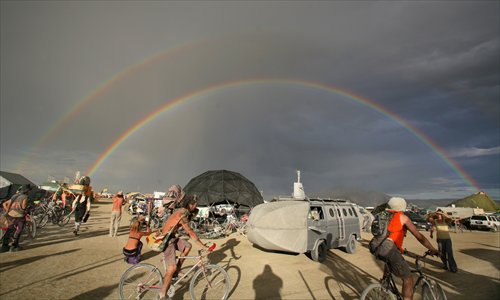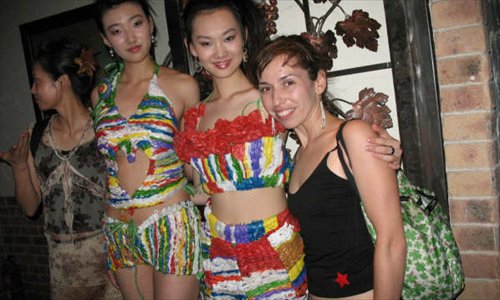Activist uses art to raise environmental awareness in Beijing

People from around the world attend the annual Burning Man festival in 2007 in Nevada, the US. Photo: CFP

Carissa Welton, right, stands with models wearing clothes made out of plastic bags in Beijing. Photo: Courtesy of Carissa Welton
Carissa Welton will always remember what a taxi driver said to her not long after she came to China.
At the time, the driver had just thrown a bottle out of the window while the car was moving. Welton tried to argue with him in Chinese, telling him that in the US it is illegal to litter, and the government would even fine someone $500 for such an action.
The driver merely looked at her and said, "We are in China," Welton remembers.
She had been in China for less than a week at that point, but as she traveled throughout the country later on, she noticed people littering everywhere.
Some might have shrugged their shoulders and forgotten about it. But Welton did her best to change the situation. She started an eco-artist's collective, Greening the Beige (GtB), to present shows, exhibits and talks to raise environmental awareness. Currently, GtB is partnering with the Today Art Museum (TAM) and hopes to develop more educational programs on the issue of environmental protection.
Inspired by art
When studying at San Francisco State University, Welton took Asian art history courses and focused on China for her senior thesis. It became a major interest of hers, and instilled in her a desire to see the country.
After graduating in 2004, Welton came to China and lived in Shandong Province, working as an English teacher. She moved to Beijing in 2005, both teaching English and working as a freelancer for a few English-language magazines.
In order to learn more about the country, in her free time, Welton traveled around China. But everywhere she went, she saw all kinds of trash on the streets. Welton says she would go to a beautiful national landmark and see people littering.
"I don't think it's just the government that needs to [preserve the environment], companies, individuals, everybody can do something together to make it better," she said.
Welton thought about teaching people through art. She believes it's not only a problem in China, but all over the world.
Getting started
Soon, an opportunity to educate the general public presented itself.
In 2006, Burning Man, an annual week-long art festival held in the Black Rock desert of Nevada, called on artists to submit proposals to make non-burnable tree sculptures. At the annual festival, a lot of the art was burned, but the plan was for the trees to go on exhibition in public spaces.
In 2007, Welton's design was chosen by the festival's committee. According to her vision, the tree had plastic bags as leaves and trunks made out of recycled metal, such as old refrigerator parts, to make a statement that resources are scarce and the environment needs to be protected.
Welton and her team set a goal of collecting 5,000 plastic bags in Beijing to make the art installation.
She started talking with different organizations in Beijing in waste management, set up a box at a local cafe, The Bookworm to receive bag donations and organized a few street cleanups. Volunteers and members from the Plastic Bag Reduction Network came to help out.
While on the streets hunting for plastic bags, some people were confused why college students and foreigners were doing the job of government workers, Welton said. They also passed out literature to explain what they were doing.
It wasn't difficult to find plastic bags a couple years ago, Welton said. "The bags were more available back then. You buy a pair of shoes, some stationery, or something at the supermarket; you get all kinds of bags in various colors."
In the process, Welton met many people in Beijing who were either working on the environment or were artists, which led her to form GtB in March 2007.
"Beige is slang for Beijing and it also refers to the color of the tainted sky here," she said.
Environmental drive
Over the years, as people came and went, the group had members from all walks of life, from fashion designers to acrobats and teachers. Over the years, more and more students have found out about the group and started joining up.
Wan Xin, who was GtB's event coordinator in 2010, told the Global Times that Welton struck her as a passionate and patient person, who has many friends and connections. In fact, many of the people who came to present were friends with Welton or have met her before.
This year, GtB established a partnership with the TAM.
Nie Xiaojin, director of the education department at the TAM, told the Global Times that partnering with GtB finally gave her a chance to do something environment-related.
Every month, the museum hosts different events, Nie said. Sometimes, the artists come in to talk about work and show some slides. They occasionally bring their own work as well. The public reception has been very positive.
However, she admits the concept of environmental protection needs to be strengthened in China, as many foreigners come to the environmental talks, but only few are Chinese.
Funding is an issue for a non-profit organization like GtB, Welton said.
The museum sponsors the monthly events this year, which means the venue and promotion are free of charge, and everybody volunteers their own time and effort to present at these events.
"However, there are many things we don't have, like an office, staff or website because we have no funding," she said.
But Welton hopes to continue such events. Even though only a small number of people actively seek out art, she thinks the more such events are held, the more likely people will stumble upon something and began caring about the environment.
Newspaper headline: Cleaning up the capital